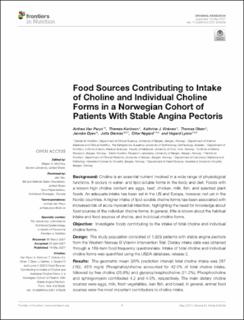Food Sources Contributing to Intake of Choline and Individual Choline Forms in a Norwegian Cohort of Patients With Stable Angina Pectoris
| dc.contributor.author | van Parys, Anthea | |
| dc.contributor.author | Karlsson, Therese | |
| dc.contributor.author | Vinknes, Kathrine | |
| dc.contributor.author | Olsen, Thomas | |
| dc.contributor.author | Øyen, Jannike | |
| dc.contributor.author | Dierkes, Jutta | |
| dc.contributor.author | Nygård, Ottar Kjell | |
| dc.contributor.author | Lysne, Vegard | |
| dc.date.accessioned | 2021-06-03T09:41:41Z | |
| dc.date.available | 2021-06-03T09:41:41Z | |
| dc.date.created | 2021-05-14T14:30:19Z | |
| dc.date.issued | 2021 | |
| dc.identifier.issn | 2296-861X | |
| dc.identifier.uri | https://hdl.handle.net/11250/2757529 | |
| dc.description.abstract | Choline is an essential nutrient involved in a wide range of physiological functions. It occurs in water- and lipid-soluble forms in the body and diet. Foods with a known high choline content are eggs, beef, chicken, milk, fish, and selected plant foods. An adequate intake has been set in the US and Europe, however, not yet in the Nordic countries. A higher intake of lipid-soluble choline forms has been associated with increased risk of acute myocardial infarction, highlighting the need for knowledge about food sources of the individual choline forms. In general, little is known about the habitual intake and food sources of choline, and individual choline forms. | en_US |
| dc.language.iso | eng | en_US |
| dc.title | Food Sources Contributing to Intake of Choline and Individual Choline Forms in a Norwegian Cohort of Patients With Stable Angina Pectoris | en_US |
| dc.type | Peer reviewed | en_US |
| dc.type | Journal article | en_US |
| dc.description.version | publishedVersion | en_US |
| dc.source.journal | Frontiers in Nutrition | en_US |
| dc.identifier.doi | 10.3389/fnut.2021.676026 | |
| dc.identifier.cristin | 1910054 | |
| cristin.ispublished | true | |
| cristin.fulltext | original | |
| cristin.qualitycode | 1 |
Tilhørende fil(er)
Denne innførselen finnes i følgende samling(er)
-
Articles [3001]
-
Publikasjoner fra CRIStin [3023]
